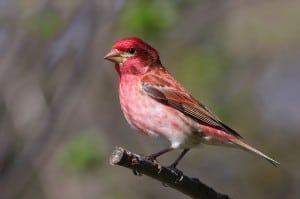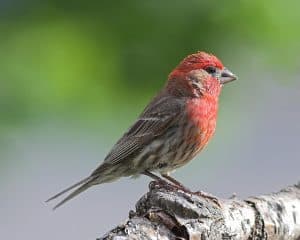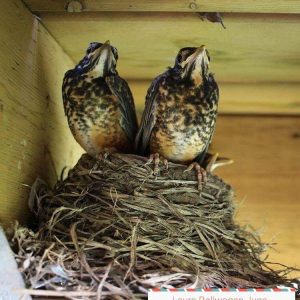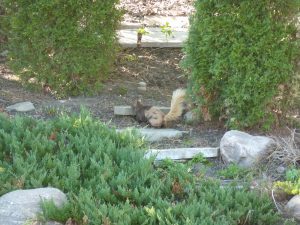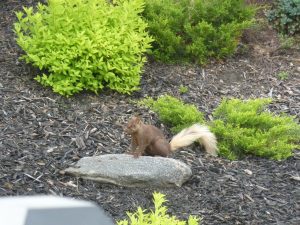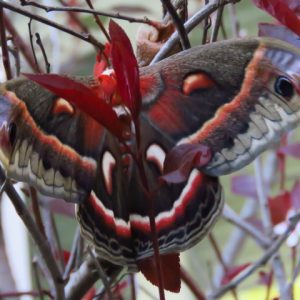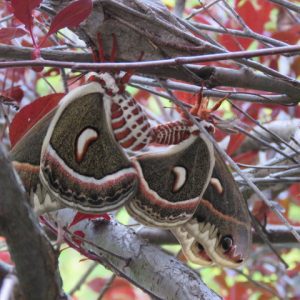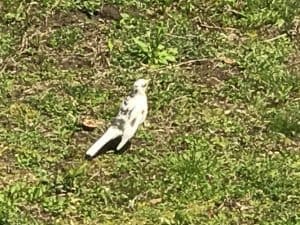Purple Finches (since early May)
This year, for the first time, we have Purple Finches coming to our feeder. They arrived in early May. I first noted a male, who showed a cinnamon, chestnut-reddish coloured head and body which morphed into a rose/raspberry by the end of May. The females gradually turned from sparrow-like to a very light rose. I think that there are two males and maybe four in total usually show in pairs or singles. One pair comes from the rail-trail behind 500 McDonnel St. Actually, the whole of the rail trail between Park and Bonnacord is interesting with Black Locust trees, a fairly large isolated wooded creek side area and a large communal garden site. Art Harron, McDonnel Street
Note: Purple Finches are quite rare in Peterborough in the summer. D.M.
Predation of robin nest (June 15)
We live on Firwood in Peterborough and had an American Robin nest in a low evergreen in front of our living room window. We were watching as the eggs were laid, hatched and the babies were fed. We watched with pride and pleasure as the parents fed their chicks and feathers had developed, and from a distance I took photos of the progress of the family. This morning, we were shocked, disappointed and devastated to see the nest empty and one baby (body about 3 inches long – perhaps dropped) on the cement walkway of our neighbour (about 15 feet from the nest). It did not seem to have any bite marks or signs of a cat or other animal attacking it but looked as if the fall had killed it. Would this be another bird stealing it from the nest?? What may have happened to the siblings? What may have happened to the parents? Is there somewhere I can find more information? Audrey Moore
Note: Nests of all kinds can be vulnerable to attacks from predators, such as Blue Jays, American Crows, Common Grackles, and many other species of birds and mammals, including cats. In Peterborough, crows seem to be the number one culprit. I have never had a robin nest on my property that has not been predated. Always sad. D.M.
Squirrel control (June 11 and 27)
We have a Red Fox that visits our yard, even climbing up onto the deck railing. We have witnessed the fox chasing squirrels all around our deck, over chairs, a table and a bench. The fox has jumped from the ground (approx. 6 feet) to the deck railing. It has often walked off with breakfast in its mouth. We have also seen it chase squirrels along the fence, which is about 8 feet high. I have some of it on video as it chased the squirrel under the deck. All this to the tune of a murder of crows voicing their displeasure – in fact, the fox’s arrival is arrival in our yard is announced by the crows.
Don Finigan, Peterborough
Note: On June 27, Don watched the fox catch a squirrel. Don writes: “I have witnessed 5 pursuits so far, in 2 of these the fox was the winner and took home breakfast. The other 3 involved 2 squirrels and 1 ground squirrel. In these 3, it was a straight race. Speed told the story. The other 2 took place on our deck with 2 levels, 6 planters, 2 tables, 1 bench, 4 chairs, 1 BBQ and 2 interior safety railings. All these obstructions for the squirrels to dodge slowed them down and gave the fox its chance to catch them. So when I come back I don’t want to be a squirrel!
Strange colour morphs in Gray Squirrels (June)
I thought these pictures of multicolored brown Eastern Gray Squirrels would be of interest to naturalists. They were taken weeks apart. Peter Ouimet, Bianco Crescent, Peterborough
Cecropia moth emerges and mates! (May 31)
Note from Tim Dyson:
Goldfinches playing in the wind? (May 6)
On Friday evening, at the height of a wind storm, but after the rain had lessened somewhat, about a dozen American Goldfinches, mostly male, converged on our birdfeeder stand and faced into the wind, rather than keep to shelter. Then, one by one, they jumped face first into the gale-force west wind, and were swept immediately back to the other end of the yard. They did this repeatedly, as though it was a game. I have never seen such strong and noisy wind, but the birds seemed to enjoy the challenge – wind-surfing! Callie Stacey, Lakefield
White American Robin (April 11)
I live in Campbellford and over the past few weeks I have observed a white robin in my backyard, just north of the Canadian Tire parking lot. It is white with a couple of grey to black patches or strips on its back, and it has a slight orange on the bottom of its breast. The eyes are black (not pink). Otherwise it looks like the white robins shown on the internet. (Google white robin) It appears to be a mature robin and has always been seen by me alone. An exception was last night when it was snowing out and it appeared on the lawn, then a rabbit came out and the two picked and ate together as the snow began to cover the lawn. By eight o’clock they had both disappeared. I have never seen one before. Paul Smith
Note: This is clearly a leucistic bird, meaning it is lacking in normal pigmentation. D.M.
Purple
